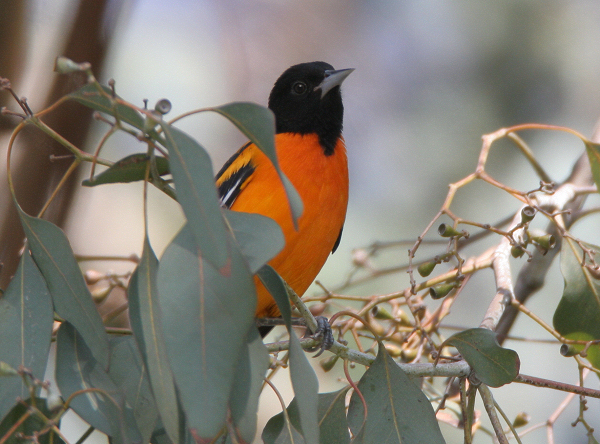
Date: 2006-10-29
Lens: Canon 600mm IS F4 + 1.4x II Converter

 Baltimore Oriole
Icterus galbula
Baltimore Oriole
Icterus galbula
 Description
Description
The male Baltimore Oriole doesn't attain its adult plumage until its second summer. Until then, immature males resemble females. Despite this, some immature males are successful in finding a mate and breeding. Un-mated birds will typically sing late into the breeding season.
Because of interbreeding and behavioral similarities, the Baltimore and Bullock's Orioles were once combined into a single species called the Northern Oriole. Genetic differences resulted in the splitting of the birds into two species.
The Baltimore Oriole feeds on caterpillars, fruits, insects, spiders, and nectar. While photographing this bird at Santee Lakes it was actively prying away the loose tree bark in search of insects. Only to eventually give up and feast on some nearby berries.
The Baltimore Oriole is the Maryland state bird. Despite having lived in Baltimore for two years, I don't recall ever seeing a Baltimore Oriole. It's kind of funny that I had to return San Diego to see this bird. Then again, I wasn't exactly looking for it when I lived in Baltimore.
General: 7 to 8.25 inches in length.
Male: Black head, throat, back, wings and tail. Orange underparts, shoulder, rump, and outer tail feather tips. Single white wing bar. White wing feather edges. Dark, pointed bill.
Immature Male: Similar to female, except with brighter orange and variable amounts of black on the head.
Female: Brownish-olive upperparts. Dull orange face, breast and undertail coverts. Grayish belly. Two white wing bars. Dark, pointed bill.
Woodland edges, open areas with scattered trees, parks, wooded urban areas.
 Nesting
Nesting4-5 pale grayish-white eggs marked with dark lines, with heaviest markings at the large end of the egg. The eggs have a 11-14 day incubation period. Fledging occurs in 11-14 days. The nest is gourd-shaped woven sack made from hair, grasses, and other plant fibers. The nest is hung from thin branches or a fork in a tall tree.